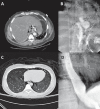Boerhaave's syndrome as an initial presentation of eosinophilic esophagitis: a case series
- PMID: 24714779
- PMCID: PMC3959943
Boerhaave's syndrome as an initial presentation of eosinophilic esophagitis: a case series
Abstract
Background: Prior studies report esophageal rupture following endoscopy or bolus impaction in eosinophilic esophagitis (EoE). The purpose of this study is to add new information to available evidence defining the clinical spectrum of spontaneous rupture (Boerhaave's syndrome) associated with vomiting in EoE.
Methods: A retrospective search of inpatient and outpatient records was conducted from January 2001 to January 2011. A faculty member in pathology blindly reviewed all esophageal biopsy specimens. EoE was defined as 15 or more eosinophils in at least 2 high-power fields (hpfs) or 25 or more eosinophils in any single HPF.
Results: In ten years, 447 patients were identified with a diagnosis of EoE. Of these, four patients presented with Boerhaave's syndrome in the setting of EoE. None of the patients had an established diagnosis of EoE prior to presentation. All cases presented with a triad of vomiting, chest pain and pneumomediastinum. In two patients, water-soluble contrast extravasation prompted surgical intervention (50%). Full thickness surgical specimen provides a unique opportunity to show eosinophils in the muscularis propria. Intraepithelial eosinophil infiltration was seen on all mucosal biopsies (>25/hpf) with significant improvement after steroid (topical or systemic) treatment.
Conclusions: Spontaneous esophageal rupture is a rare (4/447, less than 1%) but critical presentation of EoE manifesting with vomiting, chest pain and pneumomediastinum. Surgery is required if extravasation is seen with water-soluble contrast. We suggest that EoE may be a transmural disease in some patients, thus making the esophageal wall susceptible to spontaneous rupture with vomiting (Boerhaave's syndrome).
Keywords: Boerhaave’s syndrome; eosinophilic esophagitis; esophageal rupture.
Conflict of interest statement
Conflict of Interest: None
Figures


References
-
- Attwood SE, Smyrk TC, Demeester TR, et al. Esophageal eosinophilia with dysphagia. A distinct clinicopathologic syndrome. Dig Dis Sci. 1993;38:109–116. - PubMed
-
- Liacouras CA, Furuta GT, Hirano I, et al. Eosinophilic esophagitis: updated consensus recommendations for children and adults. J Allergy Clin Immunol. 2011;128:3–20. - PubMed
-
- Furuta GT, Liacouras CA, Collins MH, et al. Eosinophilic esophagitis in children and adults: a systematic review and consensus recommendations for diagnosis and treatment. Gastroenterology. 2007;133:1342–1363. - PubMed
-
- Sgouros SN, Bergele C, Mantides A. Eosinophilic esophagitis in adults: a systematic review. Eur J Gastroenterol Hepatol. 2006;18:211–217. - PubMed
-
- Straumann A, Rossi L, Simon HU, et al. Fragility of the esophageal mucosa: a pathognomonic endoscopic sign of primary eosinophilic esophagitis? Gastrointest Endosc. 2003;57:407–412. - PubMed
Publication types
LinkOut - more resources
Full Text Sources
